We can’t end our week of music from Puerto Rico without even a nod to salsa, one of Puerto Rico’s most danceable musical exports, and one of its formative stars, Rafael Cortijo.
The musical progeny of Cuban son, from which it borrows its signature 3-2 and 2-3 clave patterns, the genre may have started in Cuba and Puerto Rico but really took root in the ’60s and ’70s in New York City where Puerto Rican immigrants fused son, mambo and little guaracha to make an extraordinary new musical form. In this video meet Rafael Cortijo, a leading Puerto Rican big band leader from the ’50s and ’60s. He and his combos started by performing only plena, then branched out to merengue and, eventually, salsa.



